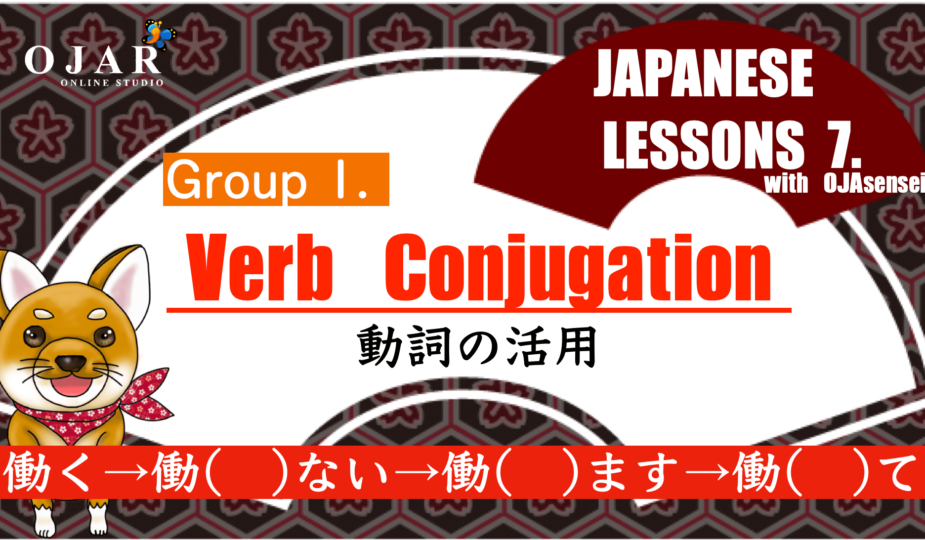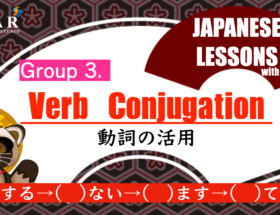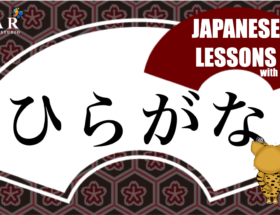Hi, ojachan is here 🙂 Let’s learn verb conjugations of Group 1 today! Basic verb conjugation is “五段活用 godan-katsuyou”. I’m going to teach you the way of grammar which Japanese kids learn.
*I can’t perfectly apply the way because Japanese learners who don’t speak Japanese as mother tongue don’t have potential knowledge for Japanese.
A Dictionary of Basic Japanese Grammar
| Amazon Reviews: | ★★★★★ |
|---|
Publisher: JAPAN TIMES
CONTENTS
Group 1 of a Verb
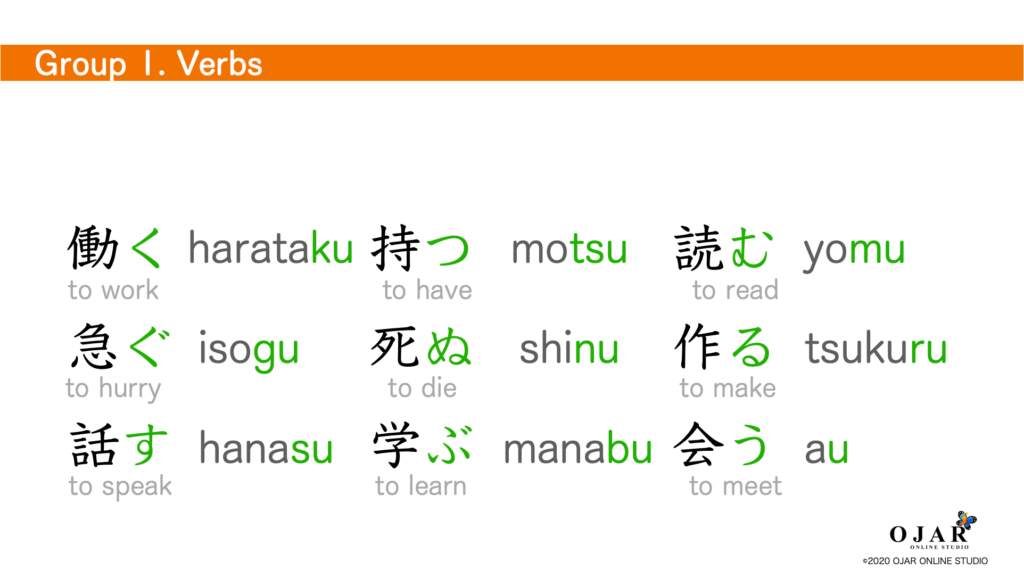
Group 1 of a verb is the verbs which conjugate with 5 vowels and it ends with “う く ぐ す つ ぬ ぶ む and る”. Japanese kids learn it in the age of 14 year-old as 五段活用 in national language class. Even Japanese kids are hard to memorize and understand the verb conjugation as they chant like “未然連用終止…ない・う・よう・ます・た・て…” repeatedly.
While Japanese learners only learn it as jisho-form, masu-form, nai-form and te-form.
Group 1 of a verb is called “-u verb”. I gave the detail lesson in this article “How to Classify Verbs”.
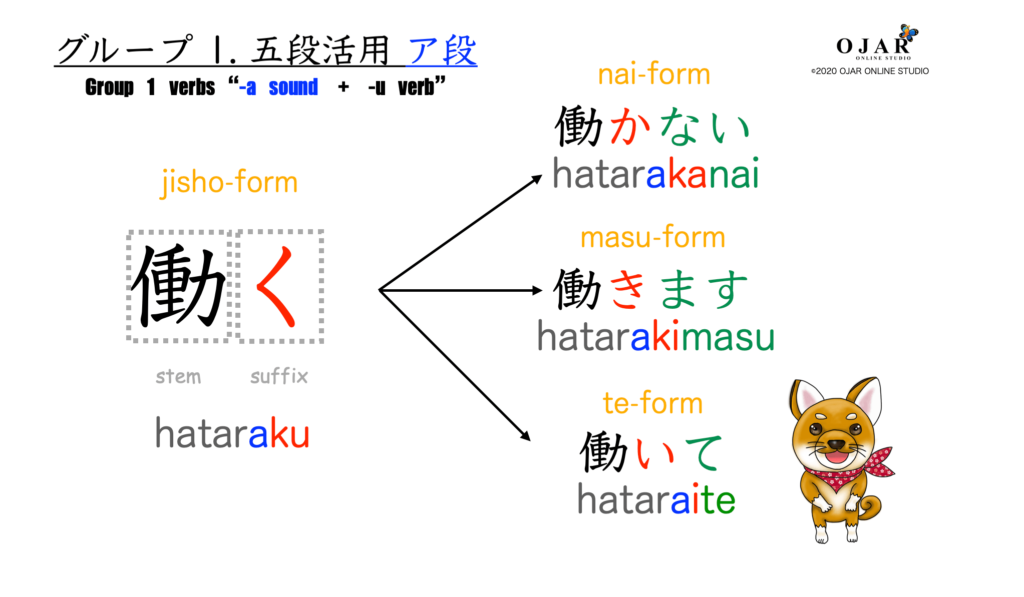
■ Forms
| 辞書形 jisho-form |
|---|
| “辞書形 jisho -form” appears in a dictionary. It’s like a “ to do” in English. It always becomes -u sound in 五段活用. When you learn verbs you need to learn this form THE FIRST definitely. |
| ない形 nai-form |
|---|
| “ない形 nai-form” conjugates to negative-form. It’s like a “not to do” in English. It always becomes -a sound in 五段活用. Japanese learners need to learn this form definitely. |
| ます形 masu-form |
|---|
| “ます形 masu-form” conjugates to polite-form. There is no expression in English. It always becomes -i sound in 五段活用. Japanese learners need to learn this form definitely. |
| て形 te-form |
|---|
| “て形 te-form” is used when the verb follows other an adjectives or a verb. It corresponds to the grammar of English “An Infinitive” or “A gerund”. You need to learn “音便 onbin” if you want to understand this conjugation. Depending whether you can understand this form or not, you can make progress of your Japanese. |
I’m going to tell you about “音便 onbin” on next article.
五段活用 godan-katsuyou
“五段活用 godan-katsuyou” is the way of conjugation for Group 1 of a verb. The big difference between classifying verbs and Verb conjugation is; we focus on the sound before the suffix when we classify verbs and we focus on the suffix itself when we conjugate a verb.
| Form | English | Meaning | Following- | conjugation sound |
|---|---|---|---|---|
| 語幹 gokan | stem | the part of a word taken off the ending | – | – |
| 未然形 mizen-kei | nai-form | the form for the thing’s happened not yet | ない う よう | -a -o |
| 連用形 renyou-kei | masu-form / te-form | the form follows an adjective or a verb | ます た て | -i |
| 終止形 shuushi-kei | jisho-form | the form ends with “。” | 。 | -u |
| 連体形 rentai-kei | – | the form follows a noun | とき こと | -u |
| 仮定形 katei-kei | – | the form for supposition | ば | -e |
| 命令形 meirei-kei | imperative form | the form for imperative form | 命令 | -e |
■ Following Other Words
| “う u” and “よう you” |
|---|
| “う u” and “よう you” are auxiliaries to make suggestions or offers. it’s same as “let’s” in English. It always becomes -o sound in 五段活用. |
| e.g. 日本語を 学ぼう。Let’s learn Japanese. |
| “た ta” |
|---|
| “た ta” are auxiliaries to make the past tense or the perfect tense. It’s same as “-ed” in English. It always becomes -i sound in 五段活用. |
| e.g. 今日 日本語を 学んだ。 kyou nihongo wo mananda I learned Japanese today. |
| “終止形 shuushi-kei a conclusive form” |
|---|
| “終止形 shuushi-kei a conclusive form” is “jisho-form a dictionary form”. It usually ends with “。読点 touten” which is same as “. period” in English. You can use it when you assert or itemize something. It always becomes -u sound in 五段活用. |
| e.g. その1. 動詞を 学ぶ sono ichi doushi wo manabu Step 1. Learning Verbs |
| “とき toki” |
|---|
| “とき toki” is a noun to make a sentence of the flow the time. It’s a same meaning of “when” as a conjunction in English. It always becomes -u sound in 五段活用. |
| e.g. 日本語を 学ぶとき、わたしは 楽しいです。nihongo wo manabu toki watashi wa tanoshii desu I am happy when I learn Japanese. |
| “こと koto” |
|---|
| “こと koto” is a noun when you use a verb as a noun. It corresponds to the grammar of English “A gerund” of “-ing”. It always becomes -u sound in 五段活用. |
| e.g. 日本語を学ぶことは、私にとって 楽しいです。 nihongo wo manabu koto wa watashi nitotte tanoshii desu Learning Japanese is fun for me. |
| “ば ba” |
|---|
| “ば ba” is a particle to make a sentence of introducing possible or impossible situations. It’s a same meaning of “if” as a conjunction in English. It always becomes -e sound in 五段活用. |
| e.g. 日本語を 学べば、楽しく アニメを 観れます。nihongo wo manabe ba tanoshiku anime wo miremasu I can enjoy watching anime if I learn Japanese. |
| “命令形 meirei-kei imperative form” |
|---|
| “命令形 meirei-kei imperative form” is used when you say “Do something.” or requests. It always becomes -e sound in 五段活用. |
| e.g. 楽しく 日本語を 学べ。tanoshiku nihongo wo manabe Learn Japanese happily |
■ The Classes of Godan-Katsuyou
The name of “五段活用 godan-katsuyou” is different depending on the conjugation of “行 gyou row” of Hiragana. The way of identifying the name is the initial of the suffix.
For example:
・書く kaku conjugates with -k sound so it’s “カ行五段活用 KAgyou-godan-katsuyou”.
・ 読む yomu conjugates with -m sound so it’s “マ行五段活用 MAgyou-godan-katsuyou”.
・ 学ぶ manabu conjugates with -b sound so it’s “バ行五段活用 BAgyou-godan-katsuyou”.
However, be careful for the exception “ワア行五段活用 WAAgyou-godan-katsuyou”.
Read this if you want to know about rows and columns of Hiragana.
1. カ行五段活用 Ends with “~く”
“カ行五段活用 KAgyou-godan-katsuyou” always ends with “~く ku” of the suffix.
Let’s think about “働くhataraku to work”.
語幹:働 hatara
活用語尾:く ku(辞書形)
活用:カ行五段活用 KAgyou-godan-katsuyou
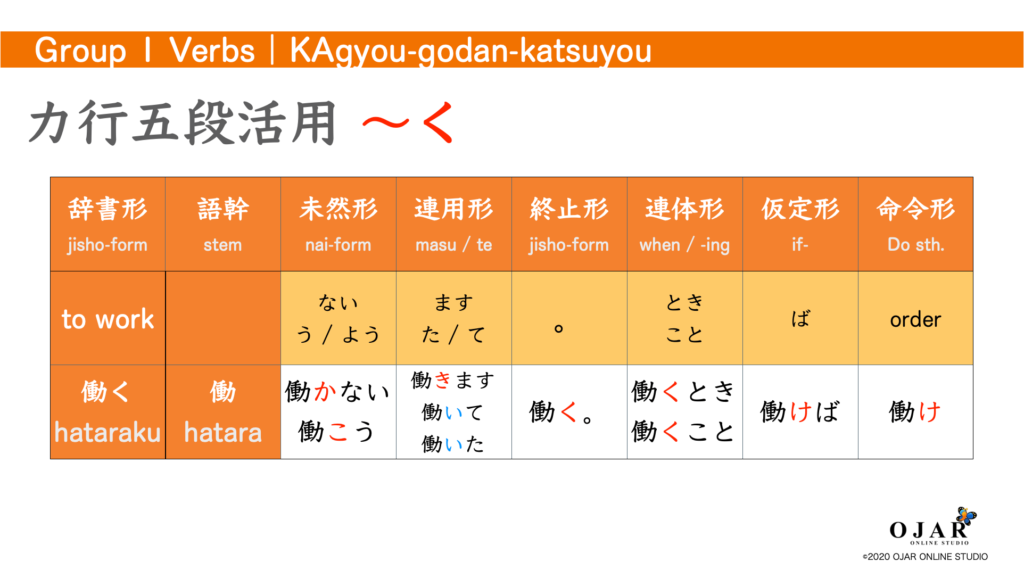
There are other verbs like this below.
| 辞書形 jisho-form | 未然形 nai-form | 連用形 masu-form / te-form | 終止形 jisho-form | 連体形 rentai-kei | 仮定形 katei-kei | 命令形 order-form |
|---|---|---|---|---|---|---|
| 聞く kiku to hear | 聞かない 聞こう | 聞きます 聞いた 聞いて | 聞く。 | 聞くとき 聞くこと | 聞けば | 聞け |
| 書く kaku to write | 書かない 書こう | 書きます 書いた 書いて | 書く。 | 書くとき 書くこと | 書けば | 書け |
| 開く hiraku to open | 開かない 開こう | 開きます 聞いた 開いて | 開く。 | 開くとき 開くこと | 開けば | 開け |
| 解く toku to solve | 解かない 解こう | 解きます 解いた 解いて | 解く。 | 解くとき 解くこと | 解けば | 解け |
| 行く iku to go | 行かない 行こう | 行きます 行った 行って | 行く。 | 行くとき 行くこと | 行けば | 行け |
2. ガ行五段活用 Ends with “~ぐ”
“ガ行五段活用 GAgyou-godan-katsuyou” always ends with “~ぐ gu” of the suffix.
Let’s think about “急ぐ isogu to hurry”.
語幹:急 iso
活用語尾:ぐ gu(辞書形)
活用:ガ行五段活用 GAgyou-godan-katsuyou
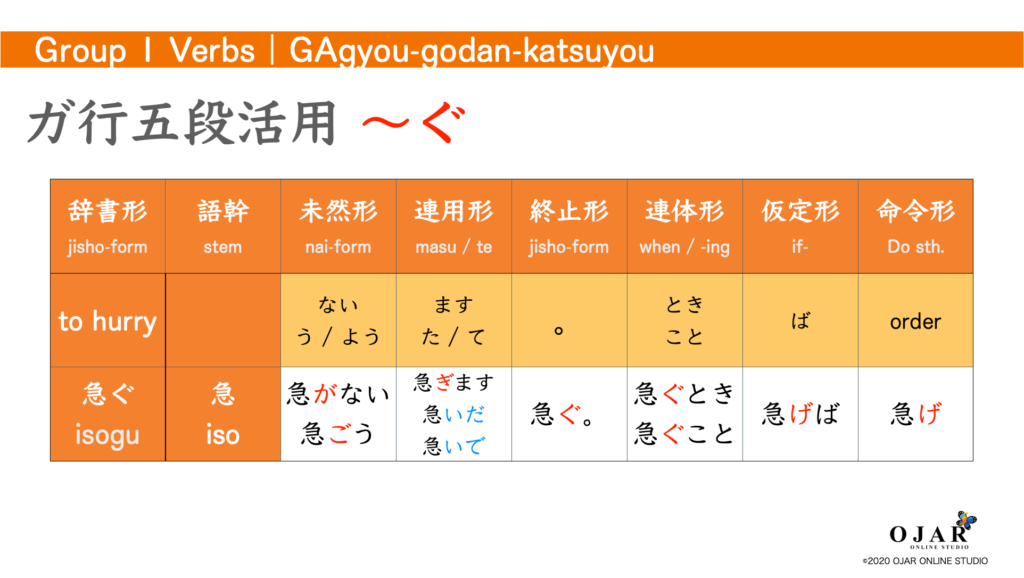
There are other verbs like this below.
| 辞書形 jisho-form | 未然形 nai-form | 連用形 masu-form / te-form | 終止形 jisho-form | 連体形 rentai-kei | 仮定形 katei-kei | 命令形 order-form |
|---|---|---|---|---|---|---|
| 泳ぐ oyogu to swim | 泳がない 泳ごう | 泳ぎます 泳いだ 泳いで | 泳ぐ。 | 泳ぐとき 泳ぐこと | 泳げば | 泳げ |
| 脱ぐ nugu to take off | 脱がない 脱ごう | 脱ぎます 脱いだ 脱いで | 脱ぐ。 | 脱ぐとき 脱ぐこと | 脱げば | 脱げ |
| 注ぐ sosogu to pour | 注がない 注ごう | 注ぎます 注いだ 注いで | 注ぐ。 | 注ぐとき 注ぐこと | 注げば | 注げ |
| 防ぐ fusegu to protect | 防がない 防ごう | 防ぎます 防いだ 防いで | 防ぐ。 | 防ぐとき 防ぐこと | 防げば | 防げ |
| 安らぐ yasuragu to settle | 安らがない安らごう | 安らぎます 安らいだ 安らいで | 安らぐ。 | 安らぐとき 安らぐこと | 安らげば | 安らげ |
3. サ行五段活用 Ends with “~す”
“サ行五段活用 SAgyou-godan-katsuyou” always ends with “~す su” of the suffix.
Let’s think about “話す hanasu to speak”.
語幹:話 hana
活用語尾:す su(辞書形)
活用:サ行五段活用 SAgyou-godan-katsuyou
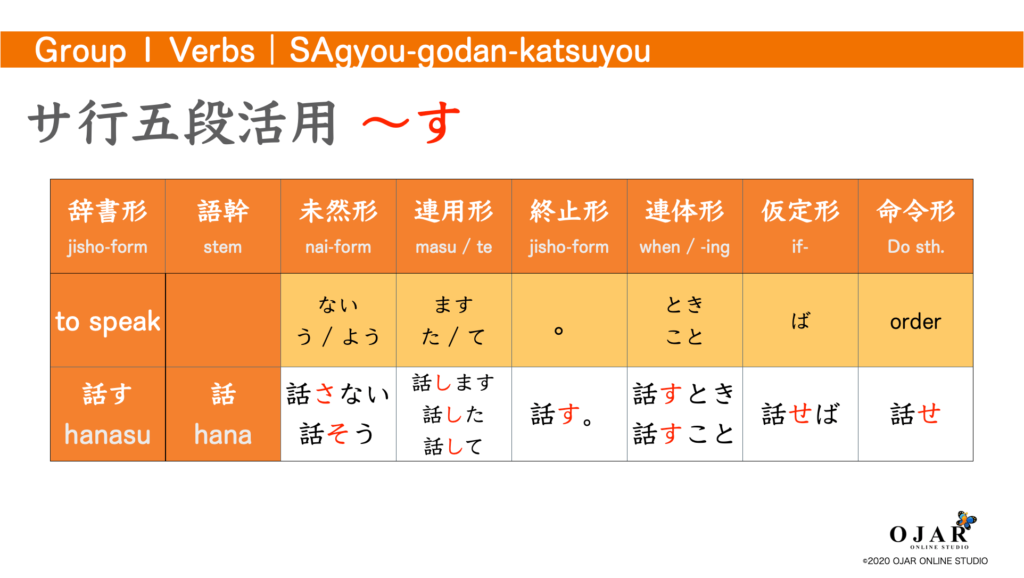
There are other verbs like this below.
| 辞書形 jisho-form | 未然形 nai-form | 連用形 masu-form / te-form | 終止形 jisho-form | 連体形 rentai-kei | 仮定形 katei-kei | 命令形 order-form |
|---|---|---|---|---|---|---|
| 逃す nigasu to release | 逃さない 逃そう | 逃します 逃した 逃して | 逃す。 | 逃すとき 逃すこと | 逃せば | 逃せ |
| 試す tamesu to try | 試さない 試そう | 試します 試した 試して | 試す。 | 試すとき 試すこと | 試せば | 試せ |
| 探す sagasu to find | 探さない 探そう | 探します 探した 探して | 探す。 | 探すとき 探すこと | 探せば | 探せ |
| 壊す kowasu to break | 壊さない 壊そう | 壊します 壊した 壊して | 壊す。 | 壊すとき 壊すこと | 壊せば | 壊せ |
| 消す kesu to delete | 消さない 消そう | 消します 消した 消して | 消す。 | 消すとき 消すこと | 消せば | 消せ |
4. タ行五段活用 Ends with “~つ”
“タ行五段活用 TAgyou-godan-katsuyou” always ends with “~つ tsu” of the suffix.
Let’s think about “持つ motsu to have”.
語幹:持 mo
活用語尾:つ tsu(辞書形)
活用:タ行五段活用 TAgyou-godan-katsuyou
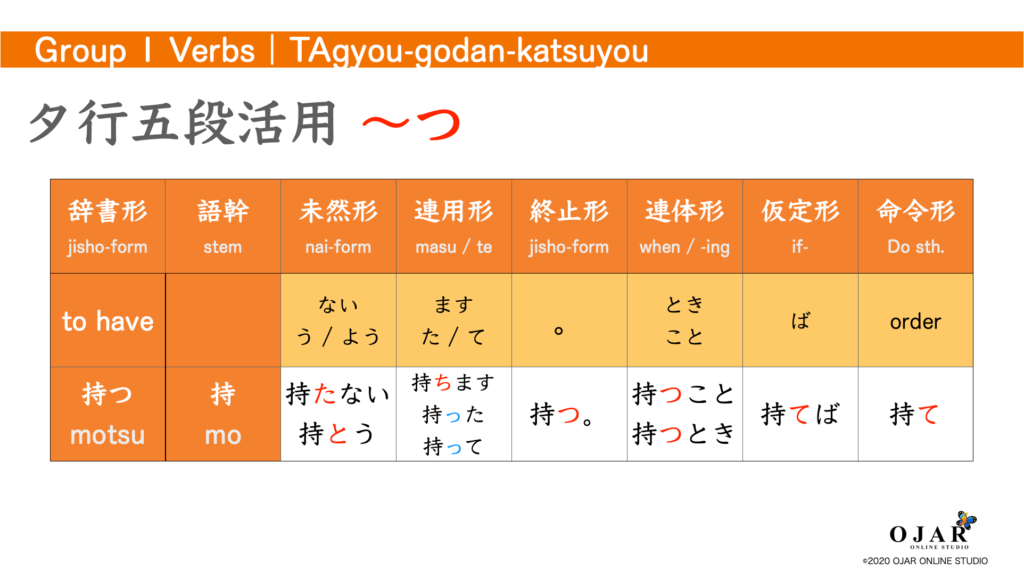
There are other verbs like this below.
| 辞書形 jisho-form | 未然形 nai-form | 連用形 masu-form / te-form | 終止形 jisho-form | 連体形 rentai-kei | 仮定形 katei-kei | 命令形 order-form |
|---|---|---|---|---|---|---|
| 勝つ katsu to win | 勝たない 勝とう | 勝ちます 勝った 勝って | 勝つ。 | 勝つとき 勝つこと | 勝てば | 勝て |
| 待つ matsu to wait | 待たない 待とう | 待ちます 待った 待って | 待つ。 | 待つとき 待つこと | 待てば | 待て |
| 立つ tatsu to stand | 立たない 立とう | 立ちます 立った 立って | 立つ。 | 立つとき 立つこと | 立てば | 立て |
| 打つ utsu to beat | 打たない 打とう | 打ちます 打った 打って | 打つ。 | 打つとき 打つこと | 打てば | 打て |
| 育つ sodatsu to grow | 育たない 育とう | 育ちます 育った 育って | 育つ。 | 育つとき 育つこと | 育てば | 育て |
5. ナ行五段活用 Ends with “~ぬ”
“ナ行五段活用 NAgyou-godan-katsuyou” always ends with “~ぬ nu” of the suffix.
Let’s think about “死ぬ shinu to die”.
語幹:死 shi
活用語尾:ぬ nu(辞書形)
活用:ナ行五段活用 NAgyou-godan-katsuyou
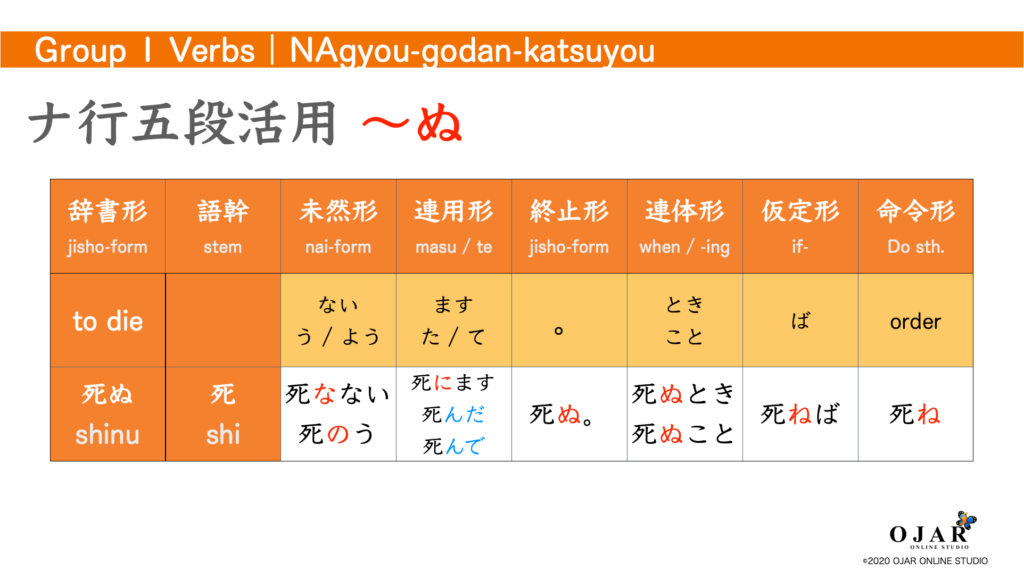
There is no other verbs.
6. バ行五段活用 Ends with “~ぶ”
“バ行五段活用 BAgyou-godan-katsuyou” always ends with “~ぶ bu” of the suffix.
Let’s think about “学ぶ manabu to learn”.
語幹:学 mana
活用語尾:ぶ bu(辞書形)
活用:バ行五段活用 BAgyou-godan-katsuyou
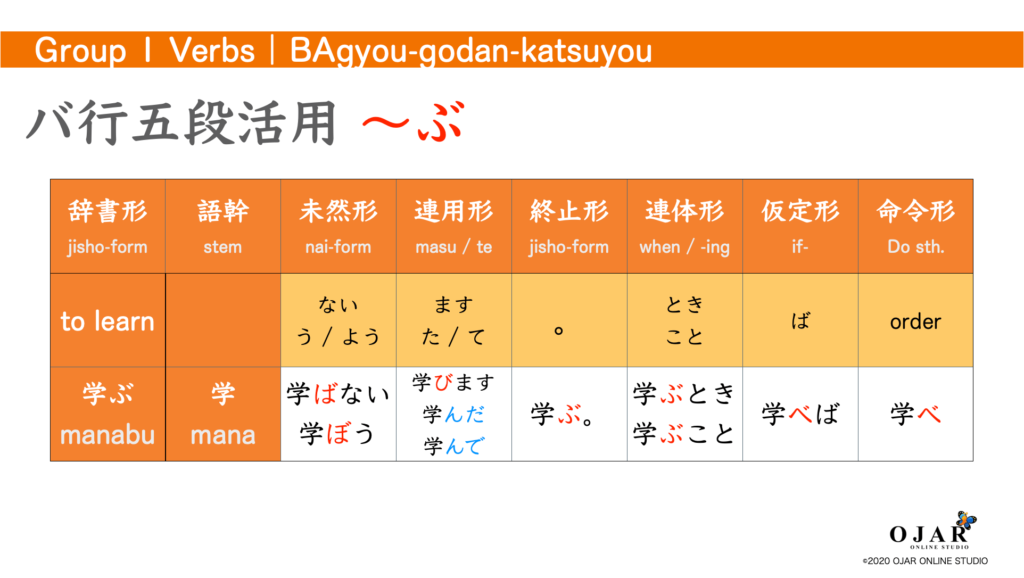
There are other verbs like this below.
| 辞書形 jisho-form | 未然形 nai-form | 連用形 masu-form / te-form | 終止形 jisho-form | 連体形 rentai-ke | i仮定形 katei-kei | 命令形 order-form |
|---|---|---|---|---|---|---|
| 呼ぶ yobu to call | 呼ばない 呼ぼう | 呼びます 呼んだ 呼んで | 呼ぶ。 | 呼ぶとき 呼ぶこと | 呼べば | 呼べ |
| 喜ぶ yorokobu to please | 喜ばない 喜ぼう | 喜びます 喜んだ 喜んで | 喜ぶ。 | 喜ぶとき 喜ぶこと | 喜べば | 喜べ |
| 叫ぶ sakebu to scream | 叫ばない 叫ぼう | 叫びます 叫んだ 叫んで | 叫ぶ。 | 叫ぶとき 叫ぶこと | 叫べば | 叫べ |
| 運ぶ hakobu to carry | 運ばない 運ぼう | 運びます 運んだ 運んで | 運ぶ。 | 運ぶとき 運ぶこと | 運べば | 運べ |
| 飛ぶ tobu to fly | 飛ばない 飛ぼう | 飛びます 飛んだ 飛んで | 飛ぶ。 | 飛ぶとき 飛ぶこと | 飛べば | 飛べ |
7. マ行五段活用 Ends with “~む”
“マ行五段活用 MAgyou-godan-katsuyou” always ends with “~む mu” of the suffix.
Let’s think about “読む yomu to read”.
語幹:読 yo
活用語尾:む mu(辞書形)
活用:マ行五段活用 MAgyou-godan-katsuyou
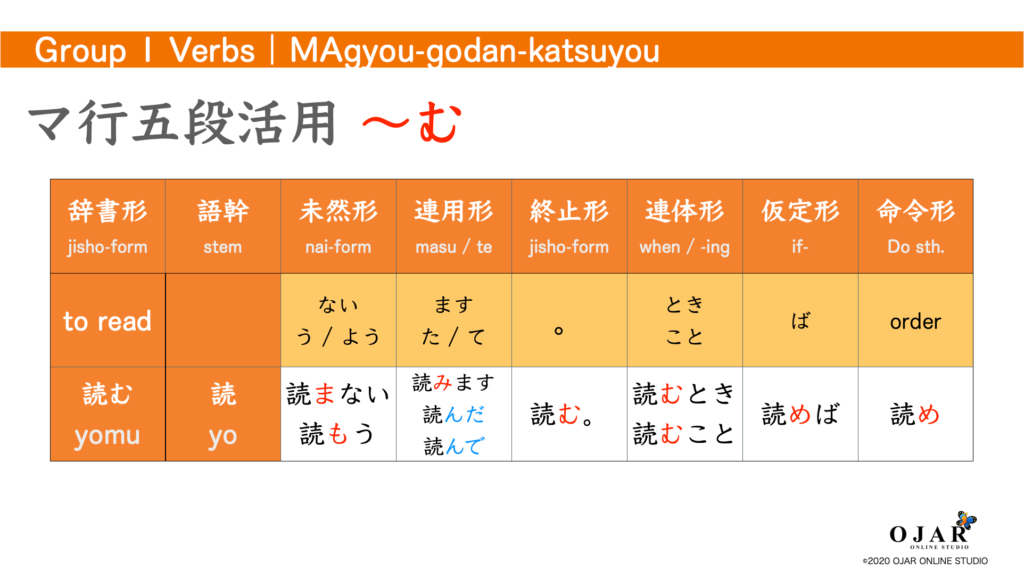
There are other verbs like this below.
| 辞書形 jisho-form | 未然形 nai-form | 連用形 masu-form / te-form | 終止形 jisho-form | 連体形 rentai-kei | 仮定形 katei-kei | 命令形 order-form |
|---|---|---|---|---|---|---|
| 住む sumu to live | 住まない 住もう | 住みます 住んだ 住んで | 住む。 | 住むとき 住むこと | 住めば | 住め |
| 悲しむ kanashimu to feel sad | 悲しまない 悲しもう | 悲しみます 悲しんだ 悲しんで | 悲しむ。 | 悲しむとき 悲しむこと | 悲しめば | 悲しめ |
| 含む fukumu to include | 含まない 含もう | 含みます 含んだ 含んで | 含む。 | 含むとき 含むこと | 含めば | 含め |
| 悩む nayamu to worry | 悩まない 悩もう | 悩みます 悩んだ 悩んで | 悩む。 | 悩むとき 悩むこと | 悩めば | 悩め |
| 挑む idomu to challenge | 挑まない 挑もう | 挑みます 挑んだ 挑んで | 挑む。 | 挑むとき 挑むこと | 挑めば | 挑め |
8. ラ行五段活用 Ends with “~る”
“ラ行五段活用 RAgyou-godan-katsuyou” always ends with “~る ru” of the suffix.
Let’s think about “作る tsukuru to make”.
語幹:作 tsuku
活用語尾:る ru(辞書形)
活用:ラ行五段活用 RAgyou-godan-katsuyou
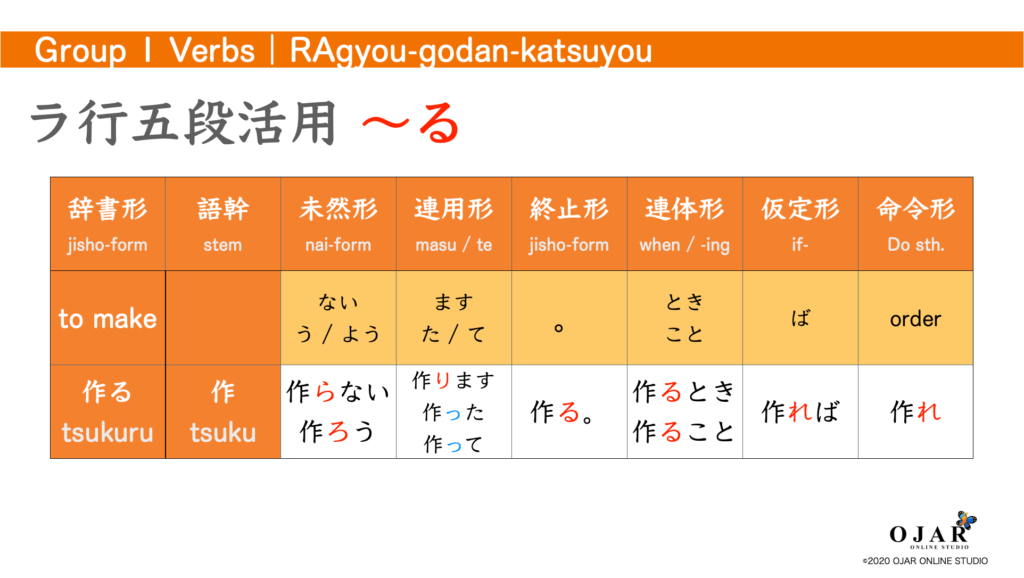
There are other verbs like this below.
| 辞書形 jisho-form | 未然形 nai-form | 連用形 masu-form / te-form | 終止形 jisho-form | 連体形 rentai-kei | 仮定形 katei-kei | 命令形 order-form |
|---|---|---|---|---|---|---|
| 走る hashiru to run | 走らない 走ろう | 走ります 走った 走って | 走る。 | 走るとき 走ること | 走れば | 走れ |
| 謝る ayamaru to apologize | 謝らない 謝ろう | 謝ります 謝った 謝って | 謝る。 | 謝るとき 謝ること | 誤れば | 謝れ |
| 送る okuru to send | 送らない 送ろう | 送ります 送った 送って | 送る。 | 送るとき 送ること | 送れば | 送れ |
| 戻る modoru to go back | 戻らない 戻ろう | 戻ります 戻った 戻って | 戻る。 | 戻るとき 戻ること | 戻れば | 戻れ |
| 頑張る ganbaru to work hard | 頑張らない 頑張ろう | 頑張ります 頑張った 頑張って | 頑張る。 | 頑張るとき 頑張ること | 頑張れば | 頑張れ |
9. ワア五段活用 Ends with “~う”
“ワア行五段活用 WAAgyou-godan-katsuyou” always ends with “~う u” of the suffix.
The reason is why this conjugation is named strangely that this verbs conjugate with –w sound and vowels because of the ancient grammar.
Let’s think about “会う au to meet”.
語幹:会 a
活用語尾:る u(辞書形)
活用:ワア行五段活用 WAAgyou-godan-katsuyou
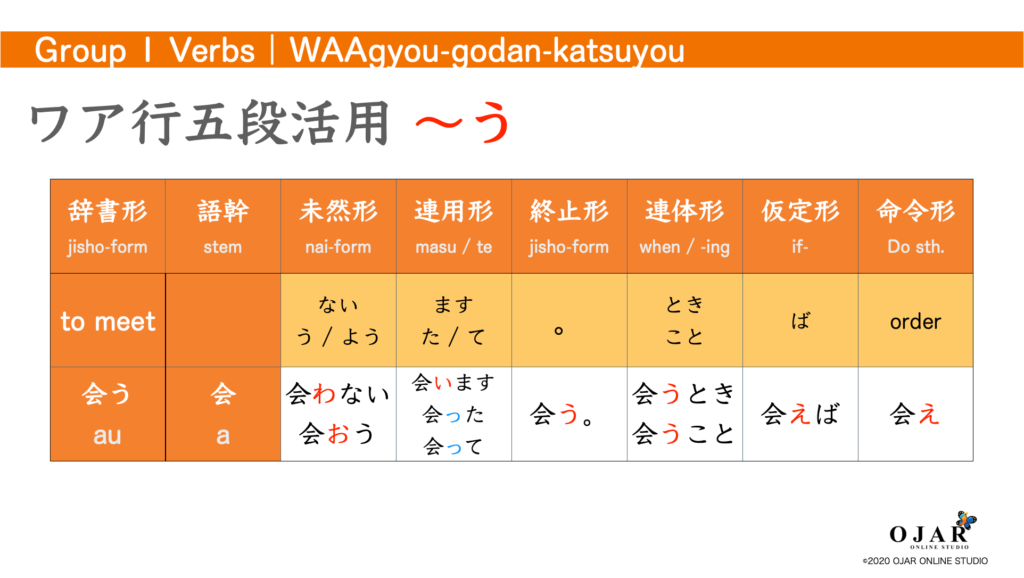
There are other verbs like this below.
| 辞書形 jisho-form | 未然形 nai-form | 連用形 masu-form / te-form | 終止形 jisho-form | 連体形 rentai-kei | 仮定形 katei-kei | 命令形 order-form |
|---|---|---|---|---|---|---|
| 買う kau to buy | 買わない 買おう | 買います 買った 買って | 買う。 | 買うとき 買うこと | 買えば | 買え |
| 言う iu to say | 言わない 言おう | 言います 言った 言って | 言う。 | 言うとき 言うこと | 言えば | 言え |
| 使う tsukau to use | 使わない 使おう | 使います 使った 使って | 使う。 | 使うとき 使うこと | 使えば | 使え |
| 歌う utau to sing | 歌わない 歌おう | 歌います 歌った 歌って | 歌う。 | 歌うとき 歌うこと | 歌えば | 歌え |
| 手伝う tetsudau to help | 手伝わない 手伝おう | 手伝います 手伝った 手伝って | 手伝う。 | 手伝うとき 手伝うこと | 手伝えば | 手伝え |
Let’s Practice
Homework
Conjugate these verbs in Japanese to the comment below!
① 押す
② 座る
③ 笑う
Okay, that’s all for today!
Good luck with your Japanese study 😉
A Dictionary of Basic Japanese Grammar
| Amazon Reviews: | ★★★★★ |
|---|
Publisher: JAPAN TIMES
P.S. My English skill is not enough yet. Please correct me with DM from CONTACT if my English is wrong. Thank you for your cooperation!
Next Lesson is; CLICK HERE!
Japanese Lesson 17:Verb Conjugation of Group 2
Previous Lesson is; CLICK HERE!
Japanese Lesson 15: Intransitive Verbs vs Transitive Verbs ( Jidoushi vs Tadoushi )

